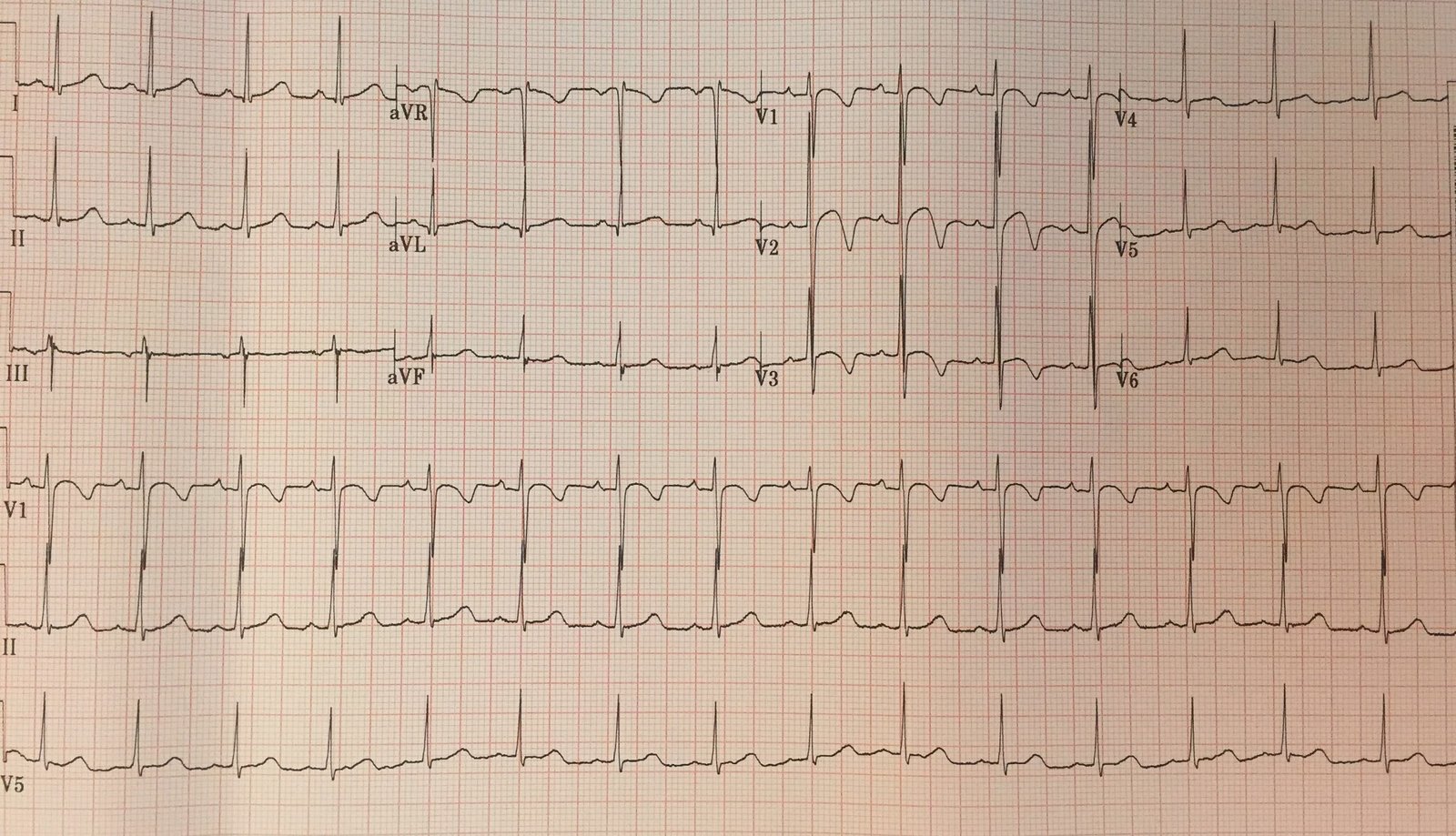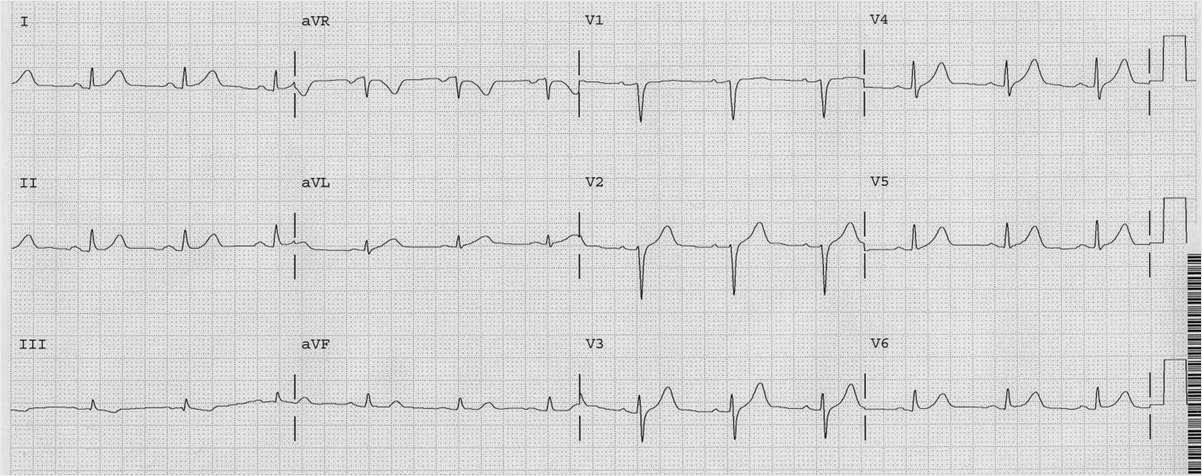This case comes from Sam Ghali (@EM_RESUS). Thanks, Sam!
An 60-something male with h/o CABG presented with chest pain.
Here is his first ED ECG:
 |
| Sinus rhythm with PVCs. There is right bundle branch block and left anterior fascicular block (Often a bad combination!–see this post) There is ST elevation in V1-V3 and upright T-waves in V2, V3.RBBB should never have ST elevation. Anywhere. Especially in leads V1-V3, there is usually up to 1 mm of ST depression with an inverted T-wave. |
There is no ST elevation in I and aVL, so this is not a proximal LAD occlusion and thus the RBBB + LAFB is probably not due to the MI (it is likely old, pre-existing) and thus does not have the same terrible prognosis as acute RBBB + LAFB in proximal LAD occlusion)
Sam activated the cath lab.
There was a slight delay.
The patient suddenly felt better, and this ECG was recorded 19 minutes after the first:
At angiogram, there was diffuse disease but no definite culprit identified. The patient was managed medically without a stent. Details are below for any who want to read them.
Unless thrombus is seen, it is very difficult to identify the culprit, though it often can be done with intravascular ultrasound (IVUS), which may identify ulcerated plaque. When there is diffuse severe CAD, this becomes very difficult.
In 5-10% of STEMI, the culprit cannot be identified.
Serial troponin T were: 0.026, 0.040, 0.049 (barely elevated).
Echo showed apical akinesis and EF of 50-55%.







Why PCI to RCA if symptomatic , why didn't start with PCI to LAD instead of RCA , especially patient have chest pain with dynamic changes in precordial leads not the inferior leads ? Thanks
Hello… How is this LAFB as there is no q wave in lead 1 although present in aVL.. Is this enough to call it LAFB?
Sir can u mark P wave in rhythm strip
I hv some doubt about wpw
There's small P with delta wave
Pz clear this thing
I can't answer that, but I did have the same question
You're technically right by criteria, but all it takes is a slight change in Q-wave axis from the 30-60 degree range to the 60-90 degree range to make the difference. Hence no criterion is exact. Delayed inscription is just as important (http://www.sciencedirect.com/science/article/pii/S0012369216397094) and this ECG shows delayed inscription of the QRS in I and aVL.
Ilyas, I agree it is hard to see. In fact, I had Sam send me several other photos of the ECG before I was certain it was sinus. As you can see, 1 of 3 rhythm strips across the bottom is left out. When I saw all 3, rhythm strips, I was convinced it was sinus. I did not post them all.
Steve Smith
Isn't jus one lead or sometimes even jus one complex showing delta wave enough to call it WPW/pre excitation…? Thx in advance..
Interesting case! I suspect the original ECG was not sinus rhythm — because of the last 2 beats in the 2nd ECG, which on the rhythm strip clearly show in lead II an upright P wave with normal PR interval that is different from what is seen prior to all other complexes on both ECGs that we see. The R-R interval just preceding these 2 last beats on the 2nd ECG is also a little bit longer — which supports the idea that the site of origin of these last 2 beats differs from the site of the other beats. Whether the other beats are due to an atrial rhythm or a slightly accelerated junctional rhythm is difficult to tell … Otherwise, marked fragmentation of the QRS in many leads together with the Q waves in V1,V2,V3 go along with the cath findings of diffuse, severe coronary disease (and account for why the LAHB that we see here looks a bit different for the terminal part of the QRS deflection in the inferior leads). THANKS to Drs. Sam Ghali & Stephen Smith for presenting this case!
In similar cases where there is an obvious ST elevation MI shortly followed by resolusion of pain and ST elevation, so in this situation the activation of cath lab mandatory ?? Or i continue on medical treatment only??
Once you've diagnosed STEMI, it is not a good idea to retreat from emergent reperfusion therapy. These patients do have better outcomes, but in those studies they all went for PCI
I have a question on RBBB, I have that condition, but when I went in to do the stress test (on the thread mill) at first the RBBB condition did not show up on the ECG, but after a while exercising or walking on the thread mill it did. I recall the Dr. saying that this was not good, and that he prefered seeing the RBBB as being consistent as against the stop and go type.
RBBB is often rate related. Your heart rate goes up and the Right bundle cannot repolarize fast enough. So it is blocked.